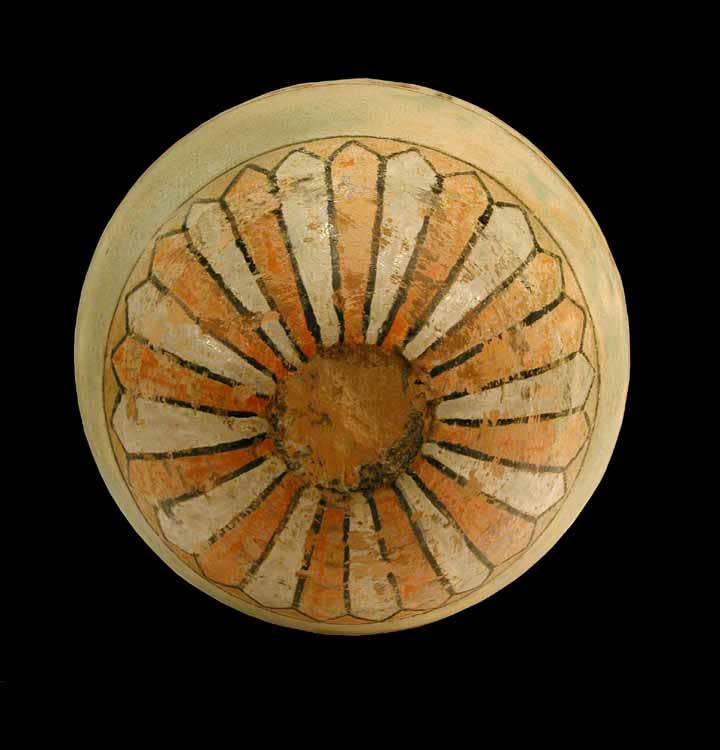Ziwiye Glazed Terracotta Jar, 800 BCE - 700 BCE
Glazed Terracotta
height 27.9 cm
height 11 in
height 11 in
X.0199 (LSO)
Further images
In 1947, a young shepherd boy stumbled upon a treasure trove of gold, silver and ivory objects located on the side of a mountain high above the small, isolated village...
In 1947, a young shepherd boy stumbled upon a treasure trove of gold, silver and ivory objects located on the side of a mountain high above the small, isolated village of Ziwiye. Excavations revealed that the treasure was located in the wall of an ancient citadel built atop the mountain peak. It is unknown who built the fortress, or destroyed it, but the architecture and decorative elements are both consistent with contemporary structures built by the Elamites and the Assyrians. Much of the art found during subsequent excavations is stylistically and subjectively similar to Assyrian art of the 8th and 7th centuries, with further links to the Urartians and Scythians. Stylistic trends in ceramics suggest that the pots have much in common with others recovered from along the banks of the Tigris in the ancient Assyrian city of Ashur, suggesting that it may have been the Assyrians who built the citadel above Ziwiye in order to defend their borders against nomadic invaders such as the Scythians.
The items recovered at Ziwiye are interesting for a number of reasons, not least because it was at this time that the technological process for producing glazed ceramics seems to have reached its apogee. Glaze is simply a thin layer of glass that covers terracotta works of art, a process originally devised some four thousands years earlier in the ancient Near East. However, it would be many thousand of years later until the art of glassmaking was finally perfected on a large scale- a process believed to have occurred in the lands of northern Mesopotamia around 1600 B.C.
This stunning, colourful vessel is a vibrant example of the new glazing technique. The entire exterior surfaced has been coated in vibrant blue, orange, and white hues, all colour fields being defined by thick black outlines. Both the upper shoulder of the vessel as well as the lower half of the tapering body have been adorned with a series of angular petals; thus in basal view the entire white, black and orange “flower” is visible. A similar design is apparent around the mouth of the jar when viewed from above. Two central bands are defined by the “petals”. The lower of these is plain, while the upper is decorated with eleven-petalled flowers interspersed with prancing stags. Additional black lines further define the features and musculature of the animals. The effect is powerful and dynamic, as well as being colourful and pleasing.
Comparatively little is known of the people who made these vessels, and the iconography is not especially informative. Stags and ibex are a common theme of the art of West Asia, from the gold works of the nomadic Scythians to the glazed wall tiles of Mesopotamian palaces. Flowers, equally, find expression in Achaemenid metal bowls and friezes. However, their juxtaposition in the painted format is generally unfamiliar. One could argue, with a certain element of uncertainty, that the lack of heavy, martial or sinister iconography might imply a non-militaristic people, and this is backed up by the slightly naïve quality of the representation. What is certain is that the rarity of this style makes it yet more desirable, and that this piece deserves pride of place in any serious collection of ancient Central Asian art.
The items recovered at Ziwiye are interesting for a number of reasons, not least because it was at this time that the technological process for producing glazed ceramics seems to have reached its apogee. Glaze is simply a thin layer of glass that covers terracotta works of art, a process originally devised some four thousands years earlier in the ancient Near East. However, it would be many thousand of years later until the art of glassmaking was finally perfected on a large scale- a process believed to have occurred in the lands of northern Mesopotamia around 1600 B.C.
This stunning, colourful vessel is a vibrant example of the new glazing technique. The entire exterior surfaced has been coated in vibrant blue, orange, and white hues, all colour fields being defined by thick black outlines. Both the upper shoulder of the vessel as well as the lower half of the tapering body have been adorned with a series of angular petals; thus in basal view the entire white, black and orange “flower” is visible. A similar design is apparent around the mouth of the jar when viewed from above. Two central bands are defined by the “petals”. The lower of these is plain, while the upper is decorated with eleven-petalled flowers interspersed with prancing stags. Additional black lines further define the features and musculature of the animals. The effect is powerful and dynamic, as well as being colourful and pleasing.
Comparatively little is known of the people who made these vessels, and the iconography is not especially informative. Stags and ibex are a common theme of the art of West Asia, from the gold works of the nomadic Scythians to the glazed wall tiles of Mesopotamian palaces. Flowers, equally, find expression in Achaemenid metal bowls and friezes. However, their juxtaposition in the painted format is generally unfamiliar. One could argue, with a certain element of uncertainty, that the lack of heavy, martial or sinister iconography might imply a non-militaristic people, and this is backed up by the slightly naïve quality of the representation. What is certain is that the rarity of this style makes it yet more desirable, and that this piece deserves pride of place in any serious collection of ancient Central Asian art.







